Top 10 Patterns from Kentucky Lake
Wind and current put most of the top 10 on similar patterns
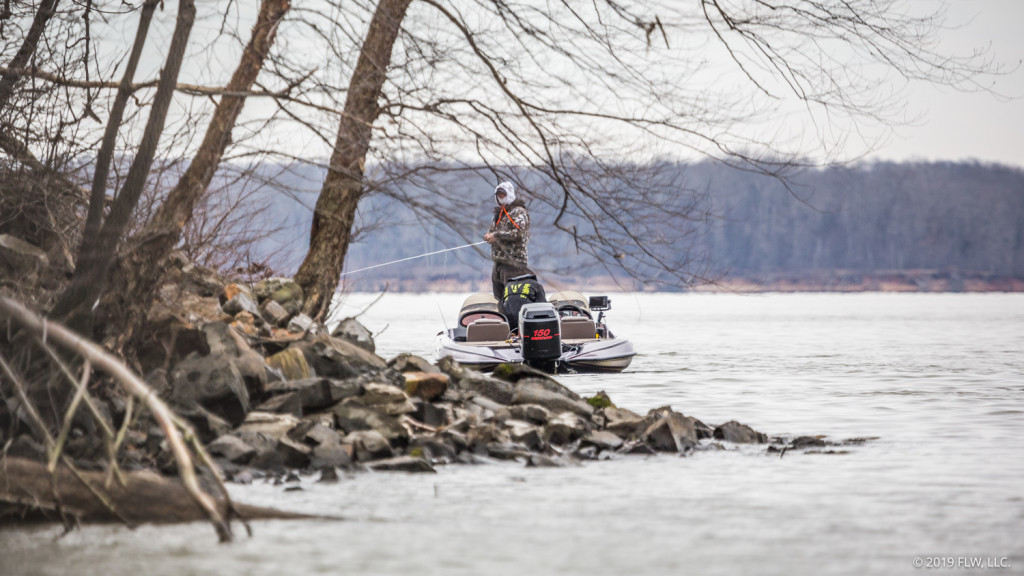
Hunter McCarty and Sloan Pennington of the University of North Alabama won the YETI FLW College Fishing Open on Kentucky Lake with a strong total of 45 pounds, 14 ounces. The pair hammered transitional points and gravel banks primarily with crankbaits for more than 22 pounds each day.
Like the winning team, many others in the top 10 targeted main-lake points and rock-to-gravel transitions – and pretty much anything that served as a current break – under somewhat tricky conditions. With the wind whipping and the water being drawn down at a rapid pace, there were a couple predominant patterns that developed throughout the event.
Here’s how the rest of the top 10 caught them on Kentucky Lake.
McCarty's and Sloan's winning pattern
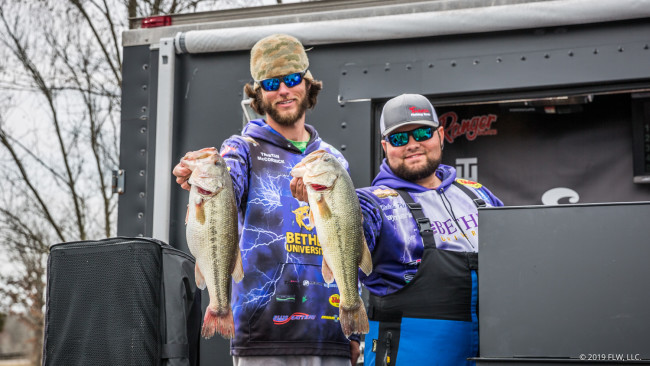
2. Pierce and McCormick run south and target current breaks
Bethel University’s Dakota Pierce and Tristan McCormick, like many of their teammates fishing in this event, are extremely familiar with the section of Kentucky Lake around Paris Landing. Bethel is just a short drive away from that ramp, and Pierce has been fishing the Tennessee River impoundment as long as he can remember.
“I just grew up on this lake, so I knew where the current breaks are,” he explains. “What I keyed on the graph was the mouth of little pockets where the water got real high up in the woods (before it was drawn down). When the water came up, all those fish are going to pull out and that’s where we keyed on.”
McCormick says the duo initially ran to Pebble Island near New Johnsonville in practice and got on a flipping bite, but that pattern fizzled by day one of the tournament. Instead, they ran a little further north to Paris Landing and focused on current breaks.
“We knew in practice, with the water coming down – it was coming down a foot and a half a day – so we knew those fish were going to come out to us,” says McCormick. “We rolled up on a place about 1 o’clock (on day one) and they were there on a current break deal. When the water gets down like this, they’re all going to pull off the bank, so that’s what we keyed on both days.
“Where we caught ours was kind of a flat. I was Power-Poled down in 3 feet of water and we were throwing to [that depth].”
Pierce and McCormick caught most of their day-one fish on YUM YUMbrella Flash Mob Jr. umbrella rigs with 3.8-inch Keitech Swing Impact FAT swimbaits. On day two, they made the switch to a black and blue Queen Tackle jig and a 1/2-ounce Strike King Red Eye Shad to do most of their damage.
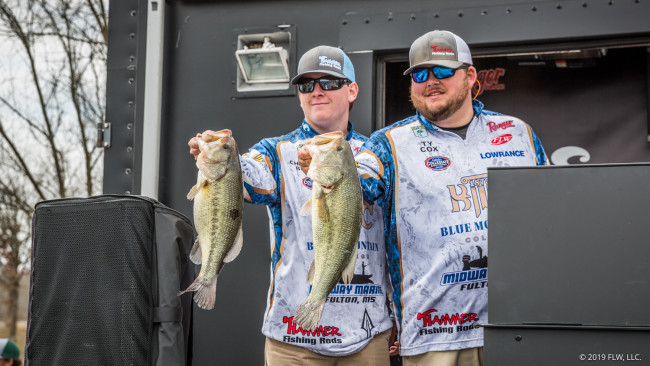
3. Cox and Boman use one bait on one spot to haul in 42-5
Ty Cox and Chandler Boman of Blue Mountain College found a shallow flat on the main lake and camped on it for both days of the tournament. This spot, however, was a little different, in that it was littered with stumps that provided natural current breaks for big fish.
“It had stumps on it,” Boman says. “The whole bar was just a current break, and the wind blew on it really good.”
Cox breaks it down even further.
“Really, what made it different was it was about 2 feet deep on top, and [on day two] the water dropped overnight,” he explains. “It made it a lot tougher because some parts were out of the water. They were more off to the end of it. They weren’t where we caught them [on day one], and it took us a while to find them, but when we did, it was good.”
The spot on which they caught all their fish was one Cox was familiar with, having fished it before in the summer. It was the last spot they found in practice, and it was all they needed.
“I knew it was going to be the deal for this time of year,” Cox says. “It was the last hole we checked the last day of practice and pulled up and doubled up on fives off it. We had 20-12 on Tuesday by 9 o’clock and laid off it. We pulled up again (on Wednesday) and caught 21-9.”
Cox and Boman only used one bait all tournament long. They targeted their shallow flat with a 1/2-ounce royal red Strike King Red Eye Shad.
“This time of year, they’re going to bite a lipless crankbait no matter what lake you go on,” says Cox. “That bait, it’s been good to us.”

4. Doty and Louis shake off bad practice, run around targeting points and pea gravel
Nathan Doty and Jacob Louis of McKendree University got off to a rough start in practice, so on day one of the tournament, they decided to just start running around the lake in search of fish on main-lake points and rock-to-gravel transitions.
“I think we had three keepers in the two days we were down here practicing,” Doty says. “It was so slow. We just decided the first day of the tournament to just run around and hit some points and find some pea gravel, because the water’s warming up and they should be staging and moving up soon.”
They caught their first fish at 9’oclock on day one, but it took until noon to catch another keeper. In the couple hours that followed, the duo had a quality limit in the boat en route to 20-7 day one.
On day two, they decided to stick with what worked and explore those same areas they caught them in the day prior, including a big creek near Cypress Bay that they picked apart. They added 19-15 on day two.
“At times we’d throw up shallow and other times we’d back off and work a little deeper because the water’s still a little high right now,” says Doty. “We did that both days.”
Doty and Louis did all their damage cranking. They employed a SPRO Little John 50 crankbait in a red craw color, but they caught most of their fish with a 1/2-ounce BOOYAH One Knocker lipless crankbait in the Rayburn red color.
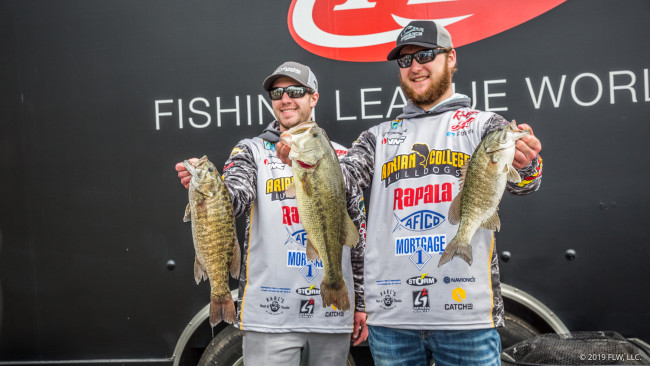
5. Henderson and Manneback crank slack, shallow water
Alex Henderson and Zach Manneback of Adrian College caught their 39-9 two-day total cranking transitional banks where composition went from chunk rock to pea gravel. It also helped to find some drains running perpendicular from the banks, which they identified from indentations in the shoreline.
“That’s what the majority of our fish came off of, and few came off main river points,” says Henderson. “We were mainly looking for 6 to 8 feet (of water). The water was higher earlier. They’ve brought it down about 4 feet since we’ve been here, so we originally started in 12 and ended in about 6 feet.
“The current did not help us at all. If we had a spot that had a lot of current around it, we would not get bit. It had to be somewhat of a slack water, slow current off the secondary channel.”
Henderson and Manneback spent all their time cranking and caught most of their fish on a No. 8 Rapala Shad Rap in Ike’s demon and crawdad colors. They stuck with those colors for their Rapala DT6 crankbaits as well, though they didn’t catch as many fish on those baits.
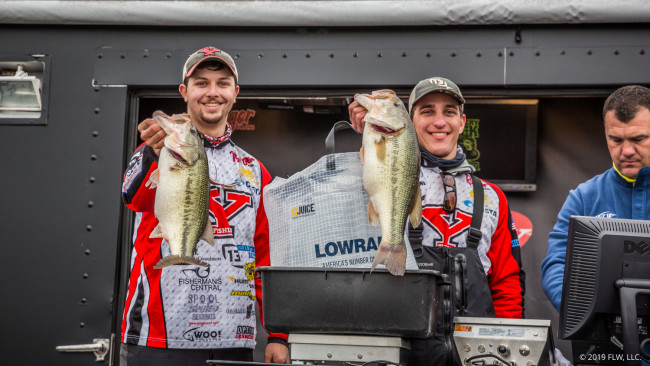
6. Creed and Latone throw up “Hail Mary,” beat bank down south
Youngstown State’s Jonathan Creed and Jared Latone didn’t have a great practice session, so on the final day of practice, they decided to swing for the fences. It paid off in a big way on day one.
"The last day before the tournament we did a Hail Mary and went down to Paris (Landing) and threw some moving baits on some main lake stuff and started catching them pretty good down there,” Creed explains. “First day of the tournament, we went back down there and caught them on a mix of prespawn patterns.”
The duo beat the bank, but they were mainly looking for transitions from chunk rock to pea gravel. It was what they call “prespawn junk fishing,” using a bunch of different baits to catch their 39-1 two-day total.
Creed and Latone narrowed down their bait selection to just a few and “cycled through them” throughout the event. They relied primarily on a Megabass Ito Vision 110 jerkbait in the Wakasagi color, an Omega Custom Tackle Rapture vibrating jig with a Zoom Super Fluke trailer and a SPRO Little John 50 crankbait in spring craw.

7. Graham and Batterson target main-lake points with current breaks
Adrian College’s Zachary Graham and Cody Batterson relied on their experience from last year’s College Open to get on a main-lake-point pattern. They mainly looked for steeper points, as the water level was dropping fast throughout the event.
“[The fish] were doing about what they did last year for us, which was main lake points,” Batterson explains. “We knew the water was going to keep dropping, so we just kind of found some steeper ones and points that had wood on them.”
Because of some engine trouble during practice, the duo was only able to explore areas not far from where they launched on practice days, down near Paris Landing. They stayed in that area during the event, primarily looking for points that served as current breaks.
“Current was also another big thing,” adds Batterson. “It was so strong the last few days. The points we were fishing, we didn’t notice as much current, and I think that’s why they were there. They were getting out of the current.”
Graham and Batterson relied on a trio of baits to land their 37-14 for the event: a Rapala DT6, a white and chartreuse Terminator spinnerbait without a trailer and an Alabama rig equipped with either Keitech Swing Impact FATs or Bass Pro Shops Speed Shad swimbaits.

8. Garrett and Palmer run dozens of spots
It didn’t matter what structure they were fishing; John Coble Garrett and Kyle Palmer of Bethel University just wanted to be out of the current.
“We were fishing on the main lake just out of the strong current,” says Garrett. “If there was a current break — it could be a high hump, it could be a rock pile, a gravel point—if you could find a flat, shallow area behind that, they wanted to be on the flat, shallow stuff just barely out of the current.”
Instead of focusing on spots with just the right mix of elements, the pair simply ran around the main lake in the Paris area in search of current breaks to land their 37-7 worth of fish.
“We didn’t necessarily have particular spots,” Garrett adds. “We ran probably 20 spots (on day two).”
Garrett and Palmer caught about half their fish on a Strike King KVD HC 2.5 square-bill crankbait in either sexy shad or citrus shad and the other half on a 3/4-ounce Strike King Red Eye Shad in the sexy shad color.
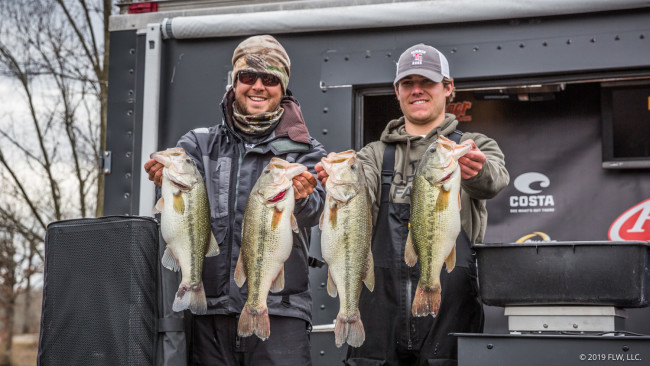
9. Floyd and McNeil join Bethel teammates in fishing around Paris Landing
Because of the ripping current up north near the dam, many teams (including the team from Bethel, who are familiar with the area) decided to fish south near Paris. Cole Floyd and Carter McNeil spent their time down there, en route to a 36-13 total, targeting any current break they could find.
“We were targeting flats on the bank,” says Floyd. “We were mostly around current breaks, or more like main-lake transitions and points. The current was pretty strong.”
The duo on got a couple good bites in practice, but with the water level dropping throughout the event, the bite turned on and their current-break pattern was the ticket.
Floyd and McNeil caught most of their fish during the event on a Strike King Red Eye Shad in the chartreuse belly craw color. They also used a white 3/4-ounce Z-Man/Evergreen ChatterBait Jack Hammer with a Lake Fork Boot Tail Baby Shad swimbait trailer.

10. McKinney and Jackson find “magical spot”
Although McKendree University’s Trevor McKinney and Blake Jackson didn’t find many fish on day two on the spot that provided their day one-leading bag, the ones they found contributed in a big way to their top-10 finish.
“We ran the exact same spot [on day two] and they just weren’t there and they weren’t biting,” says McKinney. “I think there were still a few there. We caught two. It was just tough today.”
That spot was a current break near some deep water that held a big school of smallmouths. They cycled through that area throughout the day on Tuesday, catching 10 smallmouths over 3 pounds.
While that area ran dry on day two, they did manage to land a 5-pound largemouth near check-in to salvage the day and lock up the 10th-place finish.
McKinney and Jackson relied primarily on two baits throughout the event: a SPRO RkCrawler 55 crankbait in spring craw and a 3/4-ounce Rayburn red Strike King Red Eye Shad.